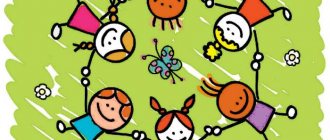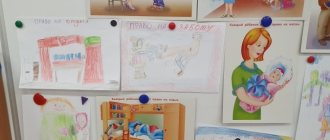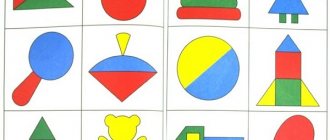Tags: Speech therapy, Development, Speech development
Children tend to have a lisp, not pronounce sounds, skip or replace them with simpler ones. This is due to the imperfection of the articulatory apparatus. Is it possible to fix this problem?
Causes of speech disorders in children
- Heredity – mental retardation, hearing impairment in parents.
- Intrauterine pathologies (the mother suffered a viral disease during pregnancy and was injured). They develop when the fetus is between 1 and 4 months old.
- Premature birth and birth injuries leading to intracranial hemorrhage.
- Diseases and injuries in the first years of life: rickets, whooping cough, meningitis, damage to the skull or palate, inflammation of the middle ear.
- Psychological reasons: parents do not communicate with the child, treat him poorly, leave him alone too often.
How do you know when it’s time to work on your child’s speech?
Initially, the child learns to pronounce sounds, then to put them into words, then to construct phrases and express thoughts. You should not expect from a two-year-old child impeccably clean pronunciation and beautiful speech, observing genders and cases. In addition, until the age of three, a child will not be able to concentrate on classes for more than 10 minutes.
The optimal age for starting classes for a healthy child is four to five years. By six he should already be able to pronounce sounds correctly and express his thoughts coherently. It is better to correct the pronunciation before the molars grow in.
Classes are needed if:
- the baby pronounces individual sounds incorrectly;
- the child rearranges syllables in words, constructs phrases incorrectly, confuses cases, gender, and numbers;
- “porridge in the mouth”;
- speech is too fast, slurred;
- the child stutters;
- the baby has suffered a birth injury or infectious disease;
- The child was diagnosed with hearing impairment, mild mental retardation, and developmental delay.
Even if you are not going to take your child to a speech therapist on an ongoing basis, it is worth bringing him for a consultation - you will receive recommendations for home activities. It is also advised to show the child to a speech therapist before school, even if there are no obvious problems.
The problem of speech disorders is not always purely speech therapy - sometimes it makes sense to correct pronunciation only after treatment.
When you need help
Reacting with a smile to words
Experts assure that you can understand what problems may arise in speech almost from birth:
- if by the end of 1 month the baby does not try to let him know by screaming that it is time for him to eat, or when he experiences discomfort;
- if at the end of 4 months he does not respond with a smile;
- if by the end of the fifth month he does not make individual sounds, pointing with his gaze at the object he means. For example, mom asks: “Where is the rattle?”;
- by the end of the 7th month does not try to attract attention with the help of spoken sounds;
- at the end of the 9th month, words consisting of repeated syllables, such as “ma-ma”, “pa-pa”, did not appear in the baby’s vocabulary;
- at 12 months does not respond to simple requests: “Give me a toy.”
Types of speech defects
Before you start classes, you need to know the types of speech disorders:
- stuttering;
- dyslalia;
- nasality;
- neurological diseases.
For your information! To identify them, you just need to regularly communicate with your child.
Card file of games on speech development for the 2nd junior group of preschool educational institutions
Basic characteristics of speech at 5-6 years old
By this time, speech develops and becomes more complex. The baby is already able to make hissing and whistling sounds. The expressiveness of speech increases, you can notice this when reading poetry and in role-playing games. It becomes coherent and sentences become more common. Children are already able to retell a fairy tale or describe a picture.
Speech problems in children
Speech disorders in children can be caused by the following reasons.
Phonetic underdevelopment
Perhaps the most common type of violation is the incorrect pronunciation of one or more sounds. Before a speech therapist, you can visit an orthodontist - sometimes the problem can be solved by cutting the frenulum.
Phonetic-phonemic underdevelopment
With such a violation, the baby cannot even hear the sound correctly. Difficulties arise with speech, writing, and learning languages. Ask your child to repeat after you the chains of words: “dom-som-kom-lom” or syllables: “gu-ku-gu-ku.” If he makes a mistake, this is a warning sign.
General underdevelopment
Poor vocabulary, difficulty expressing thoughts, inability to write a description of a picture... As a rule, such children begin to speak later than their peers. They find it difficult to concentrate and remember. In addition to a speech therapist, you will most likely need a neurologist.
Pathologies associated with injuries, heart defects, damage to the nervous system
Examples of such pathologies include alalia, aphasia and dysarthria.
Alalia occurs due to damage to the nervous system. The child speaks very poorly, and his speech is meaningless, or he does not speak at all. Also, sometimes a baby may suffer from movement disorders, hyperactivity, or, conversely, retardation.
If alalia implies that speech initially develops incorrectly or does not develop, then aphasia is an acquired disorder. It can be caused by damage to the cerebral cortex, head injuries, and heart defects. With aphasia, children do not understand other people's speech and do not control their own, do not remember words well, and change sounds and syllables.
Dysarthria is a relatively rare disorder in which a person's speech is slurred and slurred. Dysarthria is provoked by disturbances in speech breathing and articulation, which are associated with lesions of the nervous system.
Such problems need to be dealt with comprehensively - with the help of neurologists, teachers, psychologists and speech therapists.
How to create an activity at home?
The main principles of homework:
- Regularity. Exercise every day, but without overloading the baby and taking into account his age and well-being. You can start with 3-5 minutes a day, gradually increasing to 15-25.
- Game form. Only you know what your child will like most: retelling an interesting story or a competition to see who can pronounce a tongue twister the fastest. Start with tasks that are more interesting to your baby, gradually moving on to less exciting ones.
- Comfortable environment. For many types of activities you need, at a minimum, a table, a comfortable chair, and often a mirror on a stand.
- Patience. It is impossible to achieve amazing results in one mini-lesson. Encourage your child, praise him for successes and don’t get angry for mistakes, don’t laugh or imitate. Otherwise, the baby will withdraw into himself, and speech problems may worsen.
- Do not do tasks for your child if he cannot cope with them. The point of the classes is to benefit the baby, and not to impress the speech therapist.
Individual correctional classes for preschoolers
For various reasons, the process of developing full pronunciation slows down for many children. Pronunciation defects will not be eliminated on their own; to eliminate them, you need systematic exercises with a specialist, as well as joint individual lessons at home.
A well-designed training system will definitely help. Individual speech therapy classes are conducted only after consultation and examination.
Speech therapy in the form of a game
General tips for practicing at home
After a detailed diagnosis of the speech of a preschool educational institution student, it is necessary to carry out correction and begin to engage in speech therapy tasks for children. Class time should not be more than 20 minutes. According to the theory of speech therapy, if you study more than you should, the material will not be fully absorbed.
In addition, speech therapists advise practicing while playing, since play is the main activity in the preschool period.
Note! Any speech therapy classes for correcting the pronunciation of sounds are built in the form of a game.
How to build a lesson
The child will learn the material better and will not get tired at all if the tasks are in the form of a game. In addition, when working with a kindergarten student at home, it is important to structure the process correctly:
- You need to start the exercises with 3 minutes, carefully increasing the exercise time to 20 minutes.
- Organize lessons correctly so that the child has a sincere desire to study.
- It is forbidden to force you to exercise - there will be no positive results from such exercises.
- You need to exercise often, but not for long.
- Do not criticize the child for failures (an important condition), do not shout, and treat with understanding.
Speech development program for preschoolers according to O. S. Ushakova.
We need to analyze any situation, find the reason why it doesn’t work out, and try to solve it together. There are many types of speech therapy exercises. For example, the online editorial office of Shakhovskaya and Volkova offers activities and games.
Types of activities for speech development
Articulation gymnastics
This is a set of exercises that develop the speech apparatus and promote the production of sounds. Articulation gymnastics helps to pronounce words clearly and clearly even without the help of a speech therapist. Suitable for overcoming any speech defects.
You need to exercise twice a day every day. Each lesson is 3-5 minutes, each exercise is five times. You can add no more than one new exercise per day. All classes must be conducted sitting in front of a table mirror. It’s good if the mother or father does them together with the child.
Examples:
1. “Tube”: the lips are pulled forward, the teeth are closed.
2. “Barrier”: the tongue rises behind the upper teeth, the mouth is slightly open.
3. “Swing”: the tongue moves down and up alternately, in each position for several seconds.
4. “Fence”: the lips are held in a smile, the upper and lower front teeth are exposed. 5. “Pancake”: a relaxed tongue is held behind the lower teeth.
6. “Stretch”: the tongue sticks out and reaches for the nose, chin, and corners of the mouth in turn. 7. “Mushroom”: the child should smile, open his mouth wide and suck his wide tongue to the roof of his mouth.
8. “Horse”: the mouth is open, the lips are held in a smile. You need to suck the tip of your tongue to the roof of your mouth and start flicking your tongue. Performed 5-6 times.
9. “Cup”: smile, open your mouth and bend the edges of your tongue in the shape of a cup.
It is important to learn how to hold the chosen pose for the required time - for example, counting from 1 to 5 or 10.
Development of fine motor skills
The speech center of the brain is located close to the motor center. Scientists have proven that if you develop the fine motor skills of a child’s hands, that is, teach him to perform small, precise movements with his hands and fingers, the speech center will also become active. Such exercises are useful for any speech disorders.
Exercises:
- Games with plasticine. For younger children, it is enough to knead it and sculpt figures of one color; for older children, assign multi-colored figures that are more complex.
- Sorting small items (especially important in the third year of life). Mix two types of beads or buttons, peas and beans, shells and pebbles in one container and ask your child to separate one from the other. You can “tailor” some story to this - for example, one doll likes peas for dinner, and the other likes beans. Gradually complicate the task - let there be objects of three, four or more types in one container. The baby should perform the exercise with two or three fingers and bend the rest.
- Exercise with bulk substances. Teach your child to pour cereals, peas, and lentils from one dish to another (glass, bottle) using a spoon or funnel. Dip small toys and beads into the sand and ask your baby to find them and pull them out with his fingers.
- Rolling balls. The child rolls small balls on a flat surface with his palm or finger and does not allow them to slip out.
- Playing with paper. The child crumples, tears and kneads a piece of paper, learning to put it in the trash can.
- Exercise with raisins. Roll out the dough and invite your child to decorate it with raisins. Let him take each one with two fingers and place it at a distance from each other.
Finger games
One of the types of exercises is “finger games”. This is a short dramatization (often rhythmic, poetic) of stories, fairy tales using fingers. The child repeats the movements of adults.
Examples:
- I knock with a hammer (my fists knock against each other), I want to build a house (the fingertips of both hands are connected, depicting the roof of the house). I am building a tall house (palms, touching each other, rise up), I will live in that house (clap our hands).
- We wrote, we wrote (we depict the process of writing), our fingers were tired. Let's shake our fingers (shaking the hands) and start writing again (a movement similar to that at the beginning of the exercise).
- Four brothers walk towards the eldest (we connect our fingers one by one to make a pinch). Hello big! Hello, Vaska-pointer! (connect the thumb with the index finger). Hello, Little Bear! (large - with medium). Hello, Grishka the orphan! (large - with nameless). Hello, little Timoshka! (big - with little finger).
- The fingers played hide and seek and the heads were removed. Like this, like this, and the heads were removed. (All ten fingers rhythmically bend and straighten at the same time.)
- Our fingers woke up, stretched, stretched and shook. They ran, ran, ran, ran, galloped, galloped - and got tired. (We depict all the movements one by one, then shake our fingers and put our hands on our knees.)
- This finger is grandpa, this finger is grandma, this finger is daddy, this one is mommy, this one is me, this is my family! (At first, the hand is clenched into a fist, then we extend it one finger at a time, and at the end there is an open palm.)
It is advisable to perform the exercises slowly, 3 to 5 times: with one hand, then with the other hand, then with both. After each “session,” relax your fingers and hands by shaking them.
There are no strict rules on the frequency of exercise. The main thing is regularity.
Development of auditory perception, phonemic hearing
Without developed auditory perception, correct oral speech is impossible. Show children pictures of animals and ask them to reproduce the sounds they make. While walking, pay children's attention to the sounds of the street and their differences. Play audio recordings with nature sounds and ask your child what sounds and where. Introduce him to audio fairy tales.
Keep jars of pebbles, cones, vessels with water, pipes and whistles at home. Let the child make the sound from them himself.
By the first grade, a child should already have developed phonemic awareness - the ability to hear and distinguish speech sounds. He must be able to determine whether a word contains a particular sound and select words using it.
Exercises:
- "First Sound" Invite your child to name the first sound in the names of the heroes of their favorite fairy tale.
- "Cotton". Pronounce different sounds one by one - let the child clap his hands when he hears the one you asked.
- "Find similarities." Say several words with the same distinct sound and ask your child what they have in common.
- "Guess the object." Make a sound - let the child name the vegetable/fruit/toy that begins with it.
- "Lost Sound" Say the sentence so that the first sound is “lost” in one of the words, and let the child “find” it.
- "True False". Show your baby a thing, name it and repeat the word, first pronouncing one of the sounds correctly and then incorrectly. Let the child indicate which option is correct.
Vocabulary expansion
A rich vocabulary promotes effective communication and successful study, and also signals to others that this is an erudite person with a developed intellect. Vocabulary can be developed without the help of a speech therapist and at any frequency.
Active replenishment begins at approximately 2-3 years. If for a three-year-old it is enough to know about 1,200 words, then for a six- to seven-year-old child, experts estimate the norm at 3.5 thousand. It is important that the baby not only hears a word briefly, but also understands its meaning, remembers it and uses it several times. Then it will be fixed in the active dictionary.
How to help the process:
- Read to your child and with him, and most importantly, let him regularly see how enthusiastically you read books. Be sure to discuss the books you read together.
- Involve the child in the conversation, when talking with him and in front of him, speak correctly, use synonyms and antonyms.
- Play with your child. For example, in the game “Don’t take black and white, don’t say yes and no.” It begins with the question: “Are you going to the ball?” Next, the presenter builds the dialogue in such a way as to force the player to say the words “yes”, “no”, “black” or “white”, and he must answer, avoiding them. If he says it by accident, he loses.
Exercises:
- ask your child to come up with or find synonyms or antonyms for given words in the text;
- “What is a tomato? This is a vegetable. What vegetables do you know?”;
- “What is the sun doing? What morning?”;
- let the child learn to select related words (“table”, “table”, “dining room”, “tabletop”);
- ask for a detailed description of an object or creature;
- suggest matching the name of the animal with the name of its baby.
Breathing game exercises for training speech breathing
Correct speech breathing ensures proper sound production, normal timbre, clarity, volume, and expressiveness. The baby should learn to use air sparingly and control the time of exhalation.
Examples of exercises (each performed 4-5 times):
- "Blowing out the candle." Use a strip of paper as a candle, which is held 10 cm from the child’s lips. He is asked to slowly and smoothly blow on the “candle” so that the “flame” flickers. You need to blow for no longer than 10 seconds, after which there is a 5-second break.
- "Inflating a tire." The child spreads his arms in front of him, says “sh-sh-sh” as he exhales, slowly crosses his arms so that the right one is on the left shoulder and vice versa. Then takes the starting position. Then they clench their hands into fists, taking the “pump handle.” Smoothly bend forward with an exhalation on the sound “ssss.” Straightening, involuntary inhalation.
- "Airplane". Let the baby spread his arms out to the sides, palms up. Raising your head - inhale. Turn to one side with the pronunciation “zhzh”, exhale, stand straight, lower your arms, pause. The same thing - with a turn in the other direction.
- "Hedgehog". Hands on the belt, elbows bent. As you exhale, “puff-puff-puff” and move your elbows forward. Starting position, involuntary inhalation.
- "Crow". Hands rise up through the sides. The child slowly lowers his arms and squats, pronouncing “ka-a-ar” in a drawn-out manner. Starting position, involuntary inhalation.
- "Geese." Hands on the belt, slowly bend the torso forward, while keeping the head down. We pronounce it drawlingly “ga-a-a.” Starting position, inhale.
Performing exercises in which you need to inhale smoothly through your mouth, without lifting your nose, shoulders and chest, and without puffing out your cheeks.
Music games
Helps develop speech hearing and improve voice control.
Will help:
- onomatopoeic songs (“Geese-geese, ha-ha-ha”, “Kwa-kwa, says the frog”);
- games with duplicating sounds with words (the drum “does” knock-knock, boom-boom, bell - ding-ding);
- dances with short words denoting movements (top-top, jump-jump, skok-skok);
- singing sounds with mom or dad (“doo-doo-doo-dudochka”);
- performance of any song to the rhythm of clapping and stamping;
- Guessing a song by rhythm.
Pronunciation of complex sounds
Articulation develops gradually; children usually master the pronunciation of complex sounds last. Often in speech the child replaces them with simpler ones or does not pronounce them at all.
Sound "R"
Experts advise studying this difficult sound in a child at the age of 5. If the baby pronounces “r”, but incorrectly, then even earlier - then it’s more difficult to relearn.
To help:
- Tongue twisters with “r” (“Karl stole corals from Clara, and Clara stole Karl’s clarinet.”
- Imitation (just say “r” in your speech in front of the child as clearly and cleanly as possible).
- Production from other sounds that the child pronounces correctly. For example, when a child pronounces “zh”, carefully move the tongue deeper into the mouth with a stick - a “r” is formed. Strengthen the sound by repeating the exercise several times. Or the baby says “z”, lightly touching the alveoli with his tongue, and blows heavily on the tongue. The sound "r" is heard.
- Three-stage exercise: the tongue is “sucked” to the hard palate, the child takes a deep breath through the nose and a short exhale through the mouth, connecting the voice.
- Setting up mechanically (carried out only by a speech therapist - with a hammer, spatula).
Sound "Sh"
The production of this sound occurs at 3–5 years of age.
The most commonly used way is through “s”. The child raises his tongue to the sky, pronounces “s” and smoothly exhales air to make “sh”. Before directly placing the “w,” experts recommend developing articulation of the lips and tongue with the help of exercises:
- A wide smile, exposing both rows of teeth, for 5-7 seconds.
- Licking lips with a “wide tongue” from top to bottom.
- Curling the wide tip of the tongue towards the nose.
- The child stretches out his lips with a straw and blows on a cotton ball for a long time, pushing it, for example, into the corner of the table.
- The baby blows through his closed lips onto a strip of paper - stronger, weaker, stronger again.
Features of practicing hissing sounds
To teach a child to correctly pronounce hissing sounds, you must first introduce whistling sounds. If a child in the fourth year of life has learned to pronounce whistling sounds, then there should be no problems with hissing sounds. You can install them with a few simple exercises.
- "Naughty tongue." The child sticks the tip of his tongue out of his mouth. Then he lightly slaps it with his fingers, while saying: “five-five-five.”
- "Delicious jam." The lower lip is pulled down so that the teeth are visible. And the tip of the tongue licks the upper lip, as if it is very sweet there. At the same time, the lower jaw should remain motionless during the exercise.
- “Hide the candy.” Mouth closed. Tighten your tongue and touch your left, then your right cheek. It's like there's candy hiding behind your cheek.
Repeat exercises at least 5 times.
Note! Producing the sounds of native speech is very important for children. It will help them not only make contact with their peers, but also better master the preschool and school curriculum. Parents have the power to help their children avoid difficulties in the future and put the sounds correctly in time.









